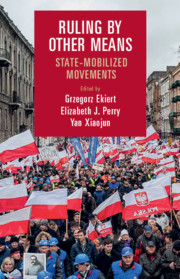Book contents
- Ruling by Other Means
- Cambridge Studies in Contentious Politics
- Ruling by Other Means
- Copyright page
- Contents
- Figures
- Tables
- Contributors
- Acknowledgments
- 1 State-Mobilized Movements: A Research Agenda
- 2 Manufactured Ambiguity
- 3 Suppressing Students in the People’s Republic of China
- 4 State-Mobilized Community Development
- 5 Enforcement Networks and Racial Contention in Civil Rights–Era Mississippi
- 6 Social Sources of Counterrevolution
- 7 Occupy Youth!
- 8 State-Mobilized Movements after Annexation of Crimea
- 9 Mirroring Opposition Threats
- 10 Mobilizing against Change
- 11 The Dynamics of State-Mobilized Movements
- 12 State-Mobilized Campaign and the Prodemocracy Movement in Hong Kong, 2013–2015
- 13 The Resurrection of Lei Feng
- Index
- Books in the Series (continued from p.iii)
- References
1 - State-Mobilized Movements: A Research Agenda
Published online by Cambridge University Press: 29 July 2020
- Ruling by Other Means
- Cambridge Studies in Contentious Politics
- Ruling by Other Means
- Copyright page
- Contents
- Figures
- Tables
- Contributors
- Acknowledgments
- 1 State-Mobilized Movements: A Research Agenda
- 2 Manufactured Ambiguity
- 3 Suppressing Students in the People’s Republic of China
- 4 State-Mobilized Community Development
- 5 Enforcement Networks and Racial Contention in Civil Rights–Era Mississippi
- 6 Social Sources of Counterrevolution
- 7 Occupy Youth!
- 8 State-Mobilized Movements after Annexation of Crimea
- 9 Mirroring Opposition Threats
- 10 Mobilizing against Change
- 11 The Dynamics of State-Mobilized Movements
- 12 State-Mobilized Campaign and the Prodemocracy Movement in Hong Kong, 2013–2015
- 13 The Resurrection of Lei Feng
- Index
- Books in the Series (continued from p.iii)
- References
Summary
On April 10, 2016, an agitated crowd gathered in the center of Warsaw. The demonstration, dubbed the “million people march,” followed the customary Polish protest repertoire. The usual sea of Polish national flags and emblems of the Solidarity movement were on display. The march began with a mass in the Warsaw Cathedral before the crowd moved across the old town to the Presidential Palace. Heavily equipped police secured the perimeter of the demonstration, and small groups of counterprotesters were separated from the main gathering. Yet, there was something odd about this “protest” event. The angry demonstrators did not make any claims against the government in power. There were no specific demands or claims against the ruling party. Moreover, the main organizer of the demonstration – the Law and Justice party – was in power in Poland.
- Type
- Chapter
- Information
- Ruling by Other MeansState-Mobilized Movements, pp. 1 - 23Publisher: Cambridge University PressPrint publication year: 2020
References
- 9
- Cited by

